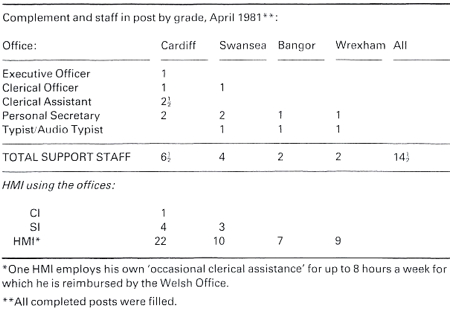[page 97]
Appendix A
List of bodies which provided evidence
(*indicates bodies whom we met.)
Local Authority Associations
Association of County Councils*
Association of Metropolitan Authorities*
Welsh Joint Education Committee.
Associations of Local Authority Education Officers and Advisers
Association of Advisers in Design and Technical Studies
East Midlands Chief Education Officers
National Association of Inspectors and Educational Advisers*
Society of Education Officers*.
Teachers' Associations
Assistant Masters' and Mistresses' Association*
National Association of Head Teachers
National Association of Schoolmasters/Union of Women Teachers*
National Association of Teachers in Further and Higher Education*
National Association of the Teachers of Wales (UCAC)
National Union of Teachers*
Secondary Heads Association.
Subject Teaching Associations
Association for Science Education
Association of Teachers of Mathematics
Confederation of Design and Technology Associations
Council of Subject Teaching Associations
National Association for Design Education
National Association for the Teaching of English.
Further and Higher Education Bodies
Association of Colleges for Further and Higher Education
Association of Principals of Colleges
[page 98]
Association of Voluntary Colleges
Committee of Directors of Polytechnics
Standing Conference of Principals and Directors of Colleges and Institutes in Higher Education.
Regional Advisory Councils for Further Education
East Anglian Regional Advisory Council for Further Education
Northern Advisory Council for Further Education
Regional Advisory Council for the Organisation of Further Education in the East Midlands
Regional Advisory Council for Technological Education, London and Home Counties
Regional Council for Further Education for the South West West Midlands Advisory Council for Further Education Yorkshire and Humberside Council for Further Education.
Other Education Bodies
Advisory Council for Adult and Continuing Education
Independent Schools Joint Council
Welsh Secondary Schools' Association*
Evidence was also received from the following individuals:
Professor John Honey, Leicester Polytechnic
Dr John Herbert, Lliswerry High School, Gwent
Jonathan May, Derby Lonsdale College
PAD Sheen, Peterborough Technical College
Sir Alan Richmond, Strode College, Street.
[page 99]
Appendix B
HM Inspectorate (England)
Table 1. Inspections of Individual Institutions and Surveys of Groups of Institutions leading to Issued Reports, 1975-1980.

Notes:
(1) Including middle deemed primary or middle deemed secondary schools.
(2) The high figures for inspections of independent schools in 1975/76 and of FHE establishments in 1980 are due in part to an increase in inspections prior to the ending of arrangements for 'recognition as efficient' of independent schools in 1978) and of independent FE colleges (in 1982). Of the 46 FHE inspections in 1980, 29 were of independent establishments.
[page 100]
Table 2. Full Inspections of Maintained Primary and Secondary Schools, 1970-1980.
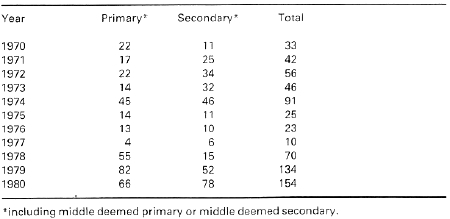
Note:
We have defined full inspections as inspections resulting in the issue of written reports to the schools concerned. During 1974-1977 and 1975-1978 HMI carried out formal inspections of 600 primary and 413 secondary schools respectively in connection with the National Primary and Secondary Surveys. These inspections were not full inspections leading to issued reports and so do not figure in the above table. Similarly, the statistics for 1978-1980 do include some full inspections as part of the National First and Middle Schools surveys.
[page 101]
Appendix C
LIST 1.
HMI publications since 1973 (including those for publication in 1981)
The publications fall into three groups: descriptions and assessments of standard provisions; accounts of good practice; and advice based on general inspection information.
I. Description and Assessment of Standard Provision
(i) Nursery and primary schools
Pre-school provision in six areas 1973, preparatory work for the research programme following the 1972 White Paper, A Framework for Expansion.
Combined nursery centres 1977, a study of the existing nine combined day nurseries/nursery schools.
Primary education in England 1978, an HMI assessment of the work of a representative sample of children, with test results in reading and mathematics.
The education of children in First Schools in preparation, an account of work in a selected group of schools.
The education of children in 9-13 Middle Schools in preparation, and to be followed by an account of the work of children in 8-12 middle schools.
(ii) Secondary schools
Curricular differences for Boys and Girls 1975
Mixed ability work in Comprehensive schools 1978
Careers Education in Secondary Schools 1973
Mathematics, Science, Modern Languages in maintained schools in England 1977, a paper for DES regional conferences.
[page 102]
Aspects of Comprehensive Education 1977, a paper for a DES conference.
Classics in Comprehensive Schools 1977
Modern Languages in Comprehensive Schools 1977
Aspects of Secondary Education 1979, a survey of the work of a representative sample of 14 and 15 year olds in English, Mathematics, Science and personal and social development.
Aspects of Secondary Education 1980 supplementary information on mathematics
Mathematics in VI Forms in preparation.
(iii) Pupils with special needs
Behavioural units 1977, produced as a result of a Ministerial conference.
Education of children in Hospitals for the Mentally Handicapped 1978
Community Homes with Education 1980, produced in co-operation with DHSS.
(iv) Teacher Training and Further Education
Developments in the BEd Degree Course 1979
The Post Graduate Certificate in the Public Sector in preparation.
Modern Languages in Further Education 1980
Educational Provision for The Young Unemployed in preparation.
II. Accounts of Good Practice
Ten Good Schools 1977, accounts of some successful secondary and special schools.
The School Curriculum and Working Life in preparation.
Girls and Science 1980
Gifted Children in Middle and Comprehensive Schools 1977
Art in Junior Education 1978
Craft, Design and Technology, some successful examples 1980
[page 103]
School Technology in preparation.
Truancy and Behavioural Problems in some urban schools 1979, description of how some schools cope with these problems.
Community Service in Education 1974
Actors in Schools 1976
III. Advice based on General Inspection Information
A View of the Curriculum 1980
Mathematics 5-11: a handbook of suggestions 1979
Curriculum 11-16 Working Papers 1977/79, a series of papers being used and evaluated in 41 schools in selected authorities.
School Geography in the Changing Curriculum 1974
The Teaching of Ideas in Geography 1978
The Use of Micro-Organisms in Schools 1977
Health Education in Schools 1977
Integrating Handicapped Children 1974
Educating Mentally Handicapped Children 1975
Safety in:
Science Laboratories 1973
Practical Departments 1973
Physical Education 1973
Further Education 1976
General Advice 1977
[page 104]
LIST 2.
Inspectorate Publications 1973-April 1981
| Year | Title | No. of
copies
sold or
distributed |
| 1973 | Safety in Science Laboratories
Safety in Practical Departments
Safety in Physical Education
Careers Education in Secondary Schools | 75,302
40,000
43,917
6,000 |
| 1974 | School Geography in the Changing Curriculum
Community Service in Education | 6,000
8,000 |
| 1975 | Educating Mentally Handicapped Children
Curricular Differences for Boys and Girls | 14,000
7,449 |
| 1976 | Safety in Further Education
Actors in Schools | 15,865
7,003 |
| 1977 | Safety at School: General Advice
The Use of Micro-Organisms in Schools
Health Education in Schools
Curriculum 11-16: Working Papers (free)
Ten Good Schools
Modern Languages in Comprehensive School
Classics in Comprehensive Schools
Gifted Children in Middle and Comprehensive Schools
Aspects of Comprehensive Education (free)
Combined Nursery Centres (free) | 47,616
8,894
8,559
34,000
11,842
10,968
5,260
11,201
No info
No info |
[page 105]
| Mathematics, Science and Modern Languages in Maintained Schools in England (free) | 2,242 |
| 1978 | The Teaching of Ideas in Geography
Mixed Ability Work in Comprehensive Schools
Education of Children in Hospitals for the Mentally Handicapped
Art in Junior Education
Primary Education in England | 6,661
6,620
3,802
4,427
36,000 |
| 1979 | Mathematics 5-11
Developments within the BEd Degree Course
Behavioural Units (free)
Truancy and Behavioural Problems in Some Urban Schools (free)
Aspects of Secondary Education in England | 13,795
4,520
13,096
14,263
12,775 |
| 1980 | A View of the Curriculum
Community Homes with Education
Modern Languages in Further Education (16-18)
Girls and Science
Craft, Design and Technology in Schools
Aspects of Secondary Education in England: Supplementary Information on Mathematics
The PGCE in the Public Sector (free) | 9,687
3,206
2,159
3,044
5,265
3,258
3,865 |
| 1981 | Schools and Working Life
Teacher Training and the Secondary School (free) | Not yet known
4,000 (reprinting) |
[page 106]
Appendix D
LIST 1
A. Issues Receiving Attention across the Board
1. Effect of expenditure policies; what schools and other institutions should cost.
2. Size of institution: effectiveness; responsiveness; cost.
3. Effects of demography, particularly at present falling rolls.
4. Curriculum (both the whole and the parts): nature; development; resource demands; assessment.
5. Teacher deployment and redeployment; education, training, re-training and other experience; 'qualification' and match.
6. Careers education and guidance.
7. Education and the world of work.
8. The institution and its community.
9. Continuity between phases/institutions.
all with related information and records
10. Co-operative working.
11. Examinations and other forms of assessment.
12. Forms of institutional self-evaluation.
13. Minority groups with special needs, including the able.
14. The impact of rural conditions.
15. Inner city factors.
16. The many faces of disadvantage; their common and different aspects.
[page 107]
B. Selection of Issues Classified by Phase and Aspect
Under-fives
1. Relative merits of modes of provision.
2. Parental involvement.
3. Changes in staffing policies.
4. Effect of closures.
Primary
1. Relative merits of different systems of school organisation - 5-11; infant/junior; first/middle ...
2. Mathematics.
3. Science.
4. Language.
5. Use of tests by LEAs.
6. Training of heads, deputies and postholders.
Secondary
1. Curriculum 11-16.
2. Girls and science.
3. Technology. (No subject is omitted from attention).
4. Examinations at 16+, 17+ and 18+.
5. 11-16 schools.
6. Co-operative and federal systems of operating schools.
7. Community education and schools.
8. Micro-electronics.
16-19
1. LEA policies and their implementation.
2. Students' access to education within different systems.
[page 108]
NAFE
1. The capacity of the system; fall of student applicants.
2. Future patterns and balance.
3. Engineering: coherent development middle level work.
4. Review of Education and Training Act 1973.
5. Handicapped in maintained/independent FE.
6. Distance learning.
7. Staff development and use of time.
8. Recurrent education.
AFE and Teacher Training
1. Pattern of advanced course provision, actual and desirable.
2. HFE/Teacher Training inter-relationship.
3. 'Rationalisation' of the 'training plant'.
4. Institutional response: relationship to mechanisms.
5. Engineering: enriched courses.
6. B Ed and PGCE courses.
7. Coordination of in-service training (1ST).
8. Priority forms of 1ST - ego management skills for heads and senior staff; upgrading academic knowledge of teachers; preparation for Warnock-type approach; teaching in a micro-electronic age; shortage subjects.
Special Education
1. Special education in ordinary schools (including special classes and units).
2. The changing population in, and future role of, special schools.
3. FE for the handicapped.
Multi-racial Education
1. Primary schools with a large ethnic minority population.
2. Second language work in the early years.
3. The curriculum in multi-racial secondary schools.
4. The implications of the EEC Directive on Mother Tongue.
Disadvantage
1. Truancy and attendance problems, including the role of the Education Welfare Service.
2. Behaviour problems - provision in schools and units, and the relationship to Social Services provision including Intermediate Treatment.
3. Provision for Travellers' children.
4. Provision for less successful and slow learning pupils. (The subject of a fair number of Area Team exercises).
5. Education in areas of high unemployment and industrial decline.
[page 109]
LIST 2.
An Illustrative list of Government Policies and Initiatives and Related DES operations requiring Inspection and Advice from HMI on determined Time Scales
i. Cutting Public Expenditure
Falling Rolls and the Reduction in the Number of School Places.
Block Grant: Educational Needs and Assessment.
Expenditure Sub-Group Education.
Capping the Pool: 'GMP' Unit Cost Exercise.
ii. Maintaining and Improving Standards
Follow-up to the Findings of the Inner London Committee.
'The School Curriculum', especially Science and Modern Languages. Cockcroft Committee of Enquiry into the Teaching of Mathematics in Schools.
Swann Committee of Enquiry into the Teaching of Ethnic Minorities. Education Bill 1981 : Special Needs in Education.
EC Mother Tongue Legislation.
Micro-electronics Programme.
APU and LEA Testing Programmes.
Examinations: Development of Single System at 16+; proposals for 17+ Examination.
Assisted Places Scheme.
Education of Gifted Children.
Development of suitable Record (Assessment for Non-Examination Pupils).
Schools, Industry and Working Life; Follow-up to Regional Conferences.
The Young Unemployed, New Training Initiatives and possible Youth Benefit.
Follow-up to Report of MacFarlane Group; Education 16-19.
Urban Programme.
Home Office White Paper: Young Offenders.
Corporal Punishment and Indiscipline.
Truancy and the Education Welfare Service.
Consultative Document on Continuing Education: Follow-up; Open Tech.
[page 110]
Management of Higher Education.
Review of Teacher Training Provision and Teacher Supply: ACSET.
Management of the Contracting Teaching Force.
Measures to increase Supply of Teachers in Shortage Subjects.
Trans-binary Working Groups, A & B.
Engineering Education: Follow-up to Finiston Report and the Conference.
Select Committee Activities.
Participation in Schools Council Activities.
Review of the Youth Service.
[page 111]
Appendix E
Exercises and surveys carried out by HMI in the field of special education
| Field | Period of Exercise |
| Education of Children in Hospitals for the Mentally Handicapped | Autumn 1976-Spring 1977 |
| Schools for ESN(M & S) Pupils | Autumn 1977-Spring 1978 |
| Special Schools for more than one handicap | Autumn 1978 |
| Ethnic Minorities in Special Schools | Autumn 1978-Autumn 1979 |
| Children with Epilepsy in Special Schools | Spring 1978-Summer 1978 |
| Education in Hospital Schools and Section 56 Arrangements | Summer 1978-Autumn 1978 |
| Provision for Maladjusted Children in ILEA | Summer Term 1979 |
| Provision for Children with Speech and Language Disorders | Autumn 1978-Summer 1979 |
| Provision for the Visually Handicapped in Schools for Physically Handicapped Children | Autumn 1979-Summer 1980 |
| Education in Psychiatric Units | Spring 1979-Autumn 1979 |
| The Curriculum 14-16 in Special Schools | Summer 1979-Spring 1980 |
| Provision in Day Schools for Maladjusted Summer Children (Metropolitan and South Midland Division) | 1980 |
| Special Education Provision in one LEA area | Autumn 1979-Summer 1980 |
| Provision for the Most Profoundly Handicapped in ESN(S) Schools | Autumn 1979-Autumn 1980 |
| Provision for physically handicapped pupils in ordinary schools | Autumn 1980-Summer 1981 |
| Severely Hearing Impaired in Ordinary Schools | Autumn 1980-Summer 1981 |
| Schools for Autistic Children | Autumn 1980-Summer 1981 |
[page 112]
Appendix F
HM Inspectorate in England and Wales
Table 1. Complement and numbers in post - 1968 to 1981

Table 2. Staff in Post on 1 June 1981
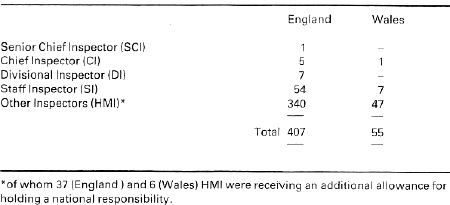
[page 113]
Table 3. Regional Deployment of HM Inspectorate in England
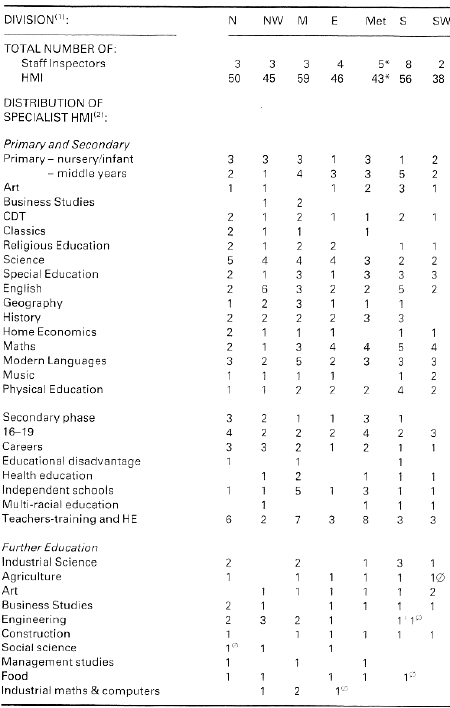
[page 114]

Notes:
(1) The seven divisions are as follows:
NORTHERN (N): Cumbria, Northumberland, Tyne and Wear, Durham, Cleveland, North, West and South Yorkshire and Humberside.
NORTH WEST (NW): Lancashire, Cheshire, Merseyside and Greater Manchester. MIDLAND (M): Shropshire, Staffordshire, Derbyshire, Nottinghamshire, Leicestershire, Warwickshire, Hereford and Worcester and the West Midlands.
EASTERN (E): Lincolnshire, Norfolk, Suffolk, Cambridgeshire, Bedfordshire, Hertfordshire, Essex and five London Boroughs.
METROPOLITAN AND SOUTH MIDLANDS (Met): Northamptonshire, Buckinghamshire, Oxfordshire, the ILEA and eight London Boroughs.
SOUTHERN (5): Berkshire, Hampshire, Surrey, Kent. East and West Sussex and seven London Boroughs.
SOUTH WESTERN (SW): Gloucestershire, Avon, Wiltshire, Dorset, Somerset, Devon and Cornwall.
(2) The figures for specialisms are illustrative only; not all specialisms are shown and some HMI work in more than one area and may appear more than once.
[page 115]
Appendix G
Costs of HM Inspectorate and Support Services in England and Wales in 1980/81
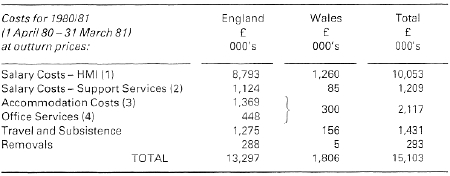
Notes:
(1) Based on average numbers in post and average HMI salaries for 1980/81, plus NI and notional cost of Pension and Gratuity Liability.
(2) Based on average numbers in post and ready reckoner average salary costs.
(3) Estimated total accommodation cost (including some notional expenditure) based on PSA calculations of average costs.
(4) Includes postage, telephones, stationery and common services.
[page 116]
Appendix H
Organisation of HMI Support Services (England)
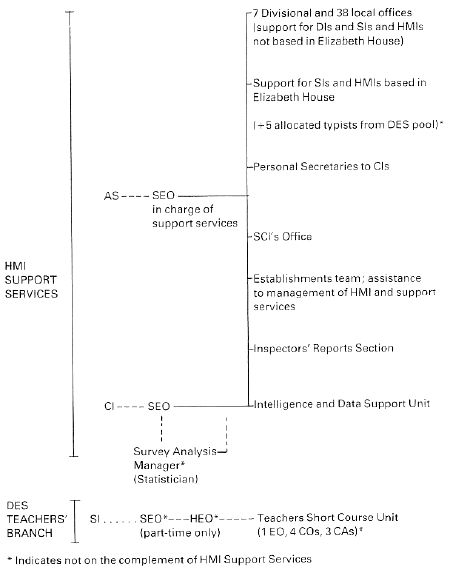
[page 117]
Table 1. Staffing of HMI Support Services (England)
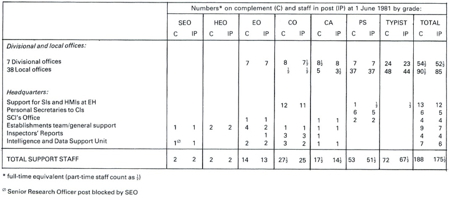 (click on the image for a larger version)
(click on the image for a larger version)
[page 118]
Table 2. Staffing of HMI Support Services (Wales)
